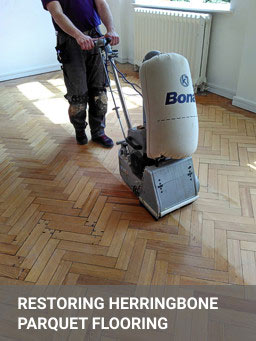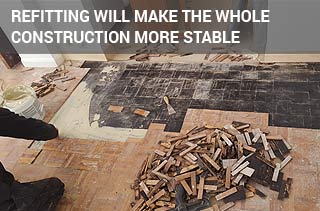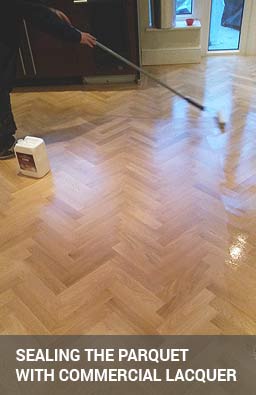Restoring Old Parquet Flooring
Let's start with an example of a nice surprise that happens in life - you remove the carpet from a room in your home and discover a valuable original parquet floor is hiding beneath it! Especially when you consider that installing a brand new parquet floor may cost anything between £70.00 - £120.00 per sqm. And that's just for a simple herringbone or basketweave pattern.
That little treasure will need a little bit of work to bring back its former beauty, and here are a few steps of advice on how to achieve it. If you are interested in booking with a professional contractor, these are the prices for floor restoration. So, without further ado, here is what you have to do in such a situation.
Missing, Damaged or Loose Blocks

Check the floor for blocks which are no longer firmly attached to the subfloor – you either notice movement or a hollow sound that comes after a ‘knock-on-wood'. Check for missing blocks – usually caused by work on the central heating or other plumbing/building work.
Parquet floors produced over the last 20 years have tongue & grooved sides used for the fitting. Handle the removal of loose/damaged blocks with care, or you may loosen connecting blocks needlessly. Missing blocks can be sourced perhaps from another room, which you do not plan to restore - cupboards in or around the room. Another option is the reclamation yards.
Before you set out to find replacements, check the size of the existing blocks - there were plenty of different types of wood blocks in Imperial measurements around when these floors were popular (1930 – 1970). Another thing to ensure for the supply is to check that the timber is of the same type to prevent colour variation between the new and the old floors from happening.
Cleaning The Blocks & Subfloor
"In the old times", parquet floors were normally fixed down with bitumen – a black tar used as ‘adhesive' which is no longer allowed to be used. Any residue of bitumen and subfloor material stuck to the blocks must also be cleared. The Bitumen will affect the bonding time of the modern adhesive you use to install the blocks back. If normally it takes between 6 – 8 hours, the bitumen may increase this to 14 or even over 24 hours!
Levelling The Subfloor
You may discover that the subfloor below the blocks removed is quite uneven. Or removing the Bitumen that has damaged the concrete or sheet material. Although we would not recommend that for solid parquet blocks, you can use an acrylic levelling compound to level a concrete floor out as best as possible – 3mm maximum per coat. Make sure that you use as strong as possible choice of self-levelling compound preferably a fibre-enhanced one. Always read the instructions carefully before you begin this type of job! And even though it is non-water based, allow sufficient time for the compound to dry before you start installing the woodblocks back.
Refitting The Blocks
If there is a height difference between the blocks, especially where old meets new – the reclaimed blocks – start with G24. Recommendations come to sand with the grain, but herringbones and various other patterns could make this a bit problematic. However, the various sandings you will have to do will sort this.
Start from one wall and ‘walk' with the belt-sander across to the opposite side; walk back, sanding the floors over the same area. After doing the last row in this direction, turn 90 degrees and redo the whole room in the same way.
Place the G40 paper on the edge-sander and tackle the areas the belt-sander couldn't reach.
Repeat the area with G80. Make sure you start the wood floor sanding with an empty dust bag - you'll need the dust of G80 for mixing with the wood filler later.
The dust from the first sanding will contain dirt and residue of the old finish layer. After finishing process 2, vacuum clean the whole floor.
Gap Filling
If you like to fill the gaps in your restored parquet flooring, mix the collected dust from the second sanding process with resin wood filler. Don't make too much at once, it dries rather quickly. Fill the larger gaps as best as possible – the excess filler on the woodblocks will be removed by the third sanding round. If you like, you can also do gap filling of the entire floor with a thin layer of filler, using a flat trowel, to fill almost every tiny gap.
After all, gaps are filled, leave the applied filler to dry out sufficiently, 30 to 60 minutes, depending on how deep the gaps were. Use G120 sanding paper for the third sanding round - this will remove the excess wood filler and give your wood floor the smoothest surface, ready to have a new finish applied to it. Once again, carefully vacuum-clean the whole floor.
Application of The Sealer

The hardwax-oil will bring up the natural beauty of the parquet floors best in a non-glossy way. The oil will penetrate the wood for long-term protection, and the wax will create your wear and tear layer, protecting your floor against dirt and drips.
Another option is the varnish. It comes in matt, satin or gloss finish. Significantly more durable than hardwax-oil-based products, the varnish requires less maintenance, although a polyurethane coat of polish is always recommended.
For both products, recommended from the trade will be Osmo, Bona and Junckers products. These products are only available in specialised wood flooring suppliers and come in bottles of 5L (varnish) or 2.5L (oil), enough for one coat of 50 sqm.
Always read the instructions for the product you're going to use.
The Perfect Finish
It's here you have to decide how perfectly you would like to finish your floor. And when we say perfect, we mean it. Using a G120 screen or G150 fine sanding disk, placed on a slow rotary machine over a white buffing pad and applied just before the final coat of the varnish or oil, will achieve the desired effect.
This fine floor sanding will put down the "hair of grain" raised by the hardening and application of your finish and let your final coat of sealant bond perfectly to the previous coat.
Job done! Allow at least 12 hours before you put the furniture back in the area.
Frequently Asked Questions About Restoring Old Parquet Flooring
Can old parquet floors be restored?
Yes — even heavily worn or neglected parquet floors can often be brought back to life through careful sanding, repairs, and refinishing. Restoration preserves the original charm and craftsmanship of the parquet pattern.
What if some parquet blocks are loose or missing?
We repair or replace damaged and missing blocks before sanding. Where possible, we source matching wood species to ensure a seamless look after restoration.
Will sanding damage the parquet pattern?
No — when carried out by professionals, parquet sanding is done diagonally or with fine equipment to protect the integrity of the geometric patterns.
Can old parquet floors be stained a different colour?
Yes — after restoration, parquet can be stained in a wide range of tones, from light modern finishes to rich dark shades, while still highlighting the distinctive design.
How long does parquet floor restoration take?
The timeframe depends on the floor’s size and condition. A typical room can take 2–3 days, including repairs, sanding, and application of protective finishes.
Is it worth restoring parquet instead of replacing it?
Absolutely — restoring original parquet is often more cost-effective and sustainable than replacing it. It also adds unique character and value to your property.